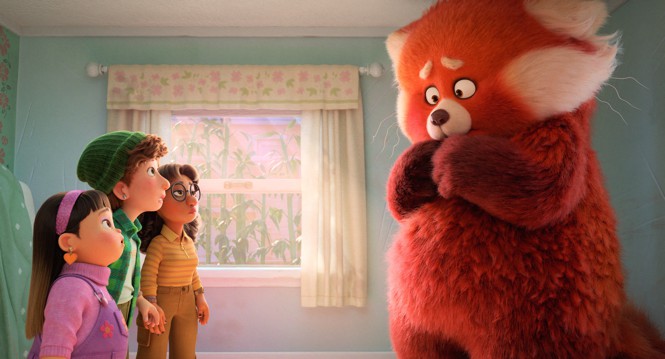Pixar’s animated films are typically defined by their impressive ambition. Monsters, Inc.; Inside Out; and Coco cleverly crafted worlds of monsters, emotions, and the afterlife that felt both logical and fantastical. Movies such as Wall-E and Up dared to embrace long narrative chunks without dialogue or juvenile antics. Recent works such as Onward, Soul, and Luca have plotted a path forward for the company that doesn’t rely on easy sequels. With all that history to consider, Turning Red might seem like a more minor project from the studio, given that it takes place in the real world, focuses on one small family, and has a very common animation trope at its center: the protagonist turning into an animal.
But overlook Turning Red at your peril. It’s the best thing Pixar’s produced in recent memory and perhaps the studio’s most emotionally nuanced and thematically clever film since Inside Out. Much like that movie, it’s concerned with the inner life of a teenage girl—still an atypical protagonist for Pixar—but unlike that movie, it doesn’t burrow into an extensive fantasy world in order to understand her feelings. Instead, director Domee Shi’s tale stays focused on the 13-year-old Chinese Canadian student Mei (voiced by Rosalie Chiang), who discovers a family secret while wrestling with a very relatable series of teenage concerns: her evolving relationship with her stern mother, the dynamics among her school friends, and the confusing body horror of puberty.
That’s where the giant red panda comes in. Shi won an Oscar for a wonderful short film called Bao, in which a woman’s relationship with a cute little anthropomorphized steamed bun became a stand-in for her empty-nest syndrome. Likewise, Turning Red personifies Mei’s transition to adulthood with another lovable cartoon character. In the script, which Shi co-wrote with the playwright Julia Cho, Mei discovers that when she experiences any kind of rush of emotion, she turns into a red panda—resplendently furry, flamboyantly scarlet, and very, very hard to ignore. The curse runs among the women in her family, her mother, Ming (Sandra Oh), reveals, and can be cured only at the next red moon, in an ancient ceremony.

Until then, so many growing pains could trigger this transformation; what’s startling about Shi’s film is that it doesn’t shyly skirt around any of them. This is the rare Pixar product that actually engages with puberty in a meaningful way, even referencing menstruation, something I can’t remember popping up in any previous cartoon under the Disney umbrella (“Did the red peony bloom?” Ming nervously asks when Mei first barricades herself inside the bathroom in her panda form). Part of the wedge between the high-achieving Mei and her demanding mother is that as she hits teenagehood, she’s becoming interested in things other than schoolwork and family—and her suddenly visible panda alter ego, ferociously free but often embarrassing, is a constant reminder of that.
The viewer gets glimpses of Mei’s notebook, filled with gooey drawings of her hanging out with her favorite boy band, 4*Town (sometimes her imagination, the film implies, gets quite scandalous). We learn that Mei’s grades are slipping as she struggles to balance homework with a growing social calendar filled by her similarly boy-band-obsessed middle-school friends. But the plot stakes of Turning Red are refreshingly low, mostly revolving around how Mei needs to learn how to control her impulses in order to stop transforming into a red panda willy-nilly, and how those emotions play into her tense relationship with her mom. Shi wrings energetic physical comedy out of Mei’s awkwardness. The character’s youthful energy can swerve from delight to shame-filled horror in an instant.
[From the May 2021 issue: Hormone monsters]
Though 3-D animation has never been my favorite form of the medium, the technology is breathtakingly deployed when it comes to Mei’s pandahood—so many individual strands of fur lovingly rendered, all part of a cuddly-looking package. The film lacks the epic sweep of some recent Pixar worlds, because it’s set in Toronto in 2002, but its visual invention lies in the little details, including the use of painted flourishes during the flashback scenes that explain the origins of Mei’s curse. That blend of styles—modern animation paired with traditional embellishments—reflects the film’s thematic tensions too. As Mei’s interests and identity shift and expand, her mother wants to keep her focused on a more familiar, academic path.
That narrative could feel thuddingly obvious. Indeed, another Pixar film, the medieval adventure Brave, tells a similar fable of mother-daughter friction and animal transformation, but delivers its message clumsily. Turning Red manages to make its cartoon characters feel like real people, so even when they’re turning into fuzzy beasts, their emotions carry nuance. Mei’s woes lead to a terrifically funny climax that parodies both kaiju movies and boy-band concert films. Indeed, the only tragedy of Turning Red is that it won’t be available on the big screen—it’s debuting solely on Disney+. That’s a shame, because this film offers the kind of inventive, humane storytelling on which the company should be proudly hanging its hat.
